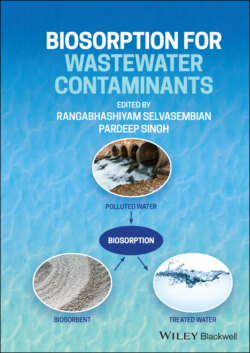Читать книгу Biosorption for Wastewater Contaminants - Группа авторов - Страница 25
Biosorption and Its Mechanism
ОглавлениеBiosorption is a simple physical and passive mechanism involving the attachment of biosorbates (metal ions) to the biosorbent surface (of biological origin) (Mrvčić et al., 2012). Simple operation, no demand for supplementary nutrients, low sludge production, lower operational cost, good performance, biosorbent rejuvenation, and no increase in chemical oxygen demand (COD) in water are all advantages of this technology that are major drawbacks of older technologies. Pollutants with parts per billion (ppb) toxicity can be eliminated by biosorption even at diluted concentrations. This process is especially important for removing heavy metals.
The first step in biosorption is to suspend the biosorbent in the biosorbate‐containing solution (metal ions). Equilibrium is achieved after incubation for a given period. The metal‐enriched biomass is separated at this point (Chojnacka, 2010). Biosorption is a dynamic mechanism in which sorbate binds to a biosorbent. Physical attachment of metal ions (Van der Waals interaction or electrostatic forces) or chemical binding (replacement of ions), chelation, precipitation, reduction, and complexation are all possible with a wide range of natural materials as biosorbents. The significant factors that control the biosorption process are (Park et al., 2010) as follows:
Nature of the biosorbent
Category of the biological ligand
Optimum parameters of sorbate and sorbent (temperature, pH, concentration)
Accessibility of binding sites
